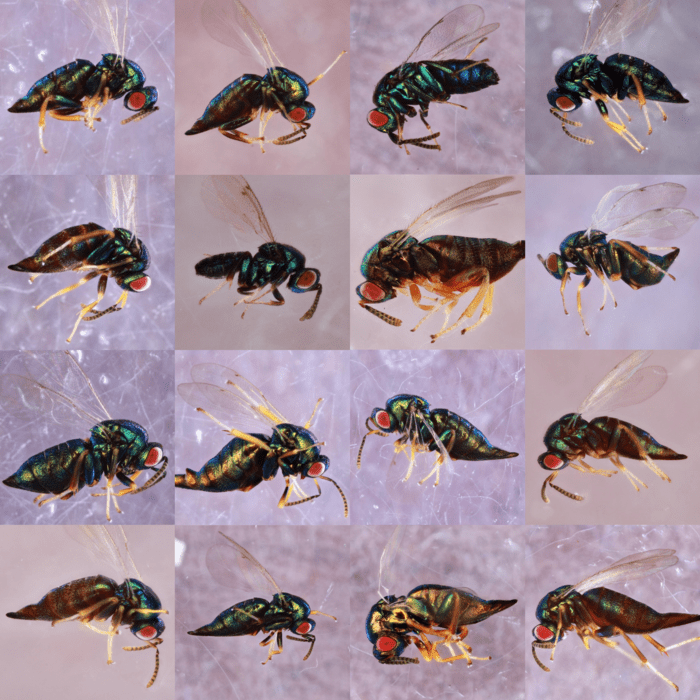In 1843, researchers described a small parasitoid wasp species; they called it Ormyrus labotus. There didn’t seem to be anything special about it at the time. Just a generalist parasite that lays its eggs in sixty-something species. But a new study found that Ormyrus labotus wasn’t one species at all — in fact, it’s 16 species that look similar in appearance but are genetically distinct.

Many species on Earth have not been discovered yet, but some are hiding under our very noses, masquerading as other species. These so-called “cryptic” species may be pretty common — according to one estimate, up to 30% of all species could be cryptic.
But the advent of relatively cheap DNA testing is enabling researchers to discover these hidden species. In a recent study, researchers uncovered the secrets of one cryptic species: a wasp that actually turned out to be 16 different wasps.
“We know so much from ecology about how important even the smallest species can be to an ecosystem,” says Andrew Forbes, Ph.D., associate professor of biology at the University of Iowa and senior author of the study, “such that uncovering this hidden diversity—and, maybe more importantly, understanding the biology of each species—becomes a critical component of conservation and maintenance of ecosystem health.”
Super exciting
This story starts in 2015, when Sofia Sheikh and Anna Ward, then graduate students in Forbes’ lab, were working on a different project. They collected galls formed on oak trees and observed the insects that emerged. They noticed that a lot of the time, the galls looked different — but when the wasps came out, it was always Ormyrus labotus. This got them wondering.
“The Forbes lab is broadly interested in how parasitic insects interact with their hosts and how that relates to species diversification,” Sheikh tells ZME Science. “Species-rich systems, like oak gall wasps and their associated parasites, are useful for addressing that question, and to that end, we had been collecting oak galls from across the country and preserving the insects that emerged from them. We were surprised to find wasps that all morphologically looked like Ormyrus labotus emerging from a diverse set of these oak gall hosts.”
This was particularly curious because many parasitic insects tend to be host-specialized — but Ormyrus labotus seemed to have an exceptionally broad range.
“This expectation led us to ask whether these wasps that all physically look like O. labotus represent one generalist species, or if they constitute several lineages, each specializing on a smaller, less variable subset of hosts,” Sheikh adds.
The idea that the wasp species could, in fact, be multiple species is not far-fetched. In fact, researchers were expecting to find diversity hiding beneath this species — though they weren’t sure just how many species they would uncover.
“Even though it may not be surprising that cryptic diversity exists, its discovery is always super exciting, because making accurate predictions about how climate change will impact species, how we protect ecosystems, etc. relies on knowing what’s out there and how it exists,” Sheikh explains to ZME Science.
What happens now
For now, Ormyrus labotus will remain a “species complex” — while researchers have established the existence of different species, they haven’t formally described and named them — this falls “a bit outside our focus,” Sheikh tells me. There’s still a lot of work to do.
“We hope that studies like these can help us better understand insect diversity and, subsequently, its conservation – the naming of species and taxonomic revision is an incredibly important dimension to this. We’d be happy to send specimens, and help however else we can, to anyone who’d like to take on the taxonomic work!”
More than 40% of insect species are declining and a third are endangered, which is why it’s so important to understand the peculiarities of these individual species. There’s still plenty of work left to be done on discerning the biology of these wasps and their evolutionary relationship with their hosts.
For Forbes, this is a clear sign that we need to pay more attention (and offer more funding) to this type of study.
“one of the aspects of this kind of work that I find endlessly amazing is that there continues to be so much undiscovered diversity hidden even in the urban and suburban parks and backyards where we made many of these collections,” the researcher concluded in an email. “For some of the reasons Sofia mentioned, the US and the world should really invest more in discovery-based biology – there is a lot more left to find!”
The study was published in Insect Systematics and Diversity.


